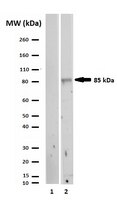Cortactin tyrosine phosphorylation promotes its deacetylation and inhibits cell spreading.
Meiler, Eugenia, et al.
PLoS ONE, 7: e33662 (2012)
2012
Show Abstract
Cortactin is a classical Src kinase substrate that participates in actin cytoskeletal dynamics by activating the Arp2/3 complex and interacting with other regulatory proteins, including FAK. Cortactin has various domains that may contribute to the assembly of different protein platforms to achieve process specificity. Though the protein is known to be regulated by post-translational modifications such as phosphorylation and acetylation, how tyrosine phosphorylation regulates cortactin activity is poorly understood. Since the basal level of tyrosine phosphorylation is low, this question must be studied using stimulated cell cultures, which are physiologically relevant but unreliable and difficult to work with. In fact, their unreliability may be the cause of some contradictory findings about the dynamics of tyrosine phosphorylation of cortactin in different processes. | 22479425
 |












